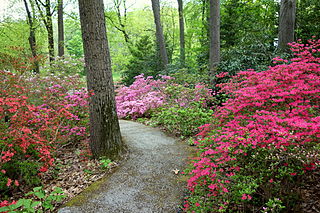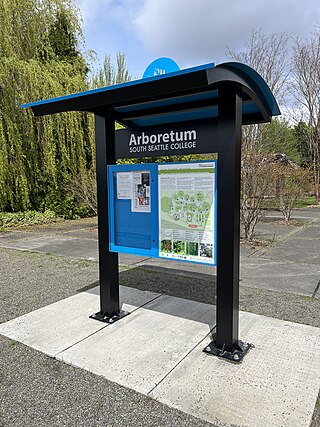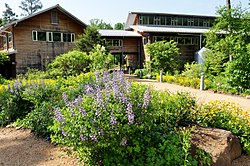
An arboretum is a botanical collection composed exclusively of trees of a variety of species. Originally mostly created as a section in a larger garden or park for specimens of mostly non-local species, many modern arboreta are in botanical gardens as living collections of woody plants and is intended at least in part for scientific study.

The Arnold Arboretum of Harvard University is a botanical research institution and free public park, located in the Jamaica Plain and Roslindale neighborhoods of Boston, Massachusetts. Established in 1872, it is the oldest public arboretum in North America. The landscape was designed by Charles Sprague Sargent and Frederick Law Olmsted and is the second largest "link" in the Emerald Necklace. The Arnold Arboretum's collection of temperate trees, shrubs, and vines has an emphasis on the plants of the eastern United States and eastern Asia, where arboretum staff and colleagues are sourcing new material on plant collecting expeditions. The arboretum supports research in its landscape and in its Weld Hill Research Building.

New England Botanic Garden at Tower Hill is a 171-acre botanic garden and arboretum located in Boylston, Massachusetts, approximately 8 miles (13 km) north of central Worcester in Worcester County, Massachusetts. The Garden features 18 distinct gardens, preserved woodlands, and miles of walking trails.
The Viles Arboretum 224 acres is a botanical garden and arboretum located in Augusta, Maine, United States, with 5 miles (8 km) of trails, open year round without charge. The plant collection contains over 300 species or varieties of trees and shrubs. The forested portion of the Arboretum is a certified Tree Farm Demonstration Area containing many of Maine's native trees.

The Connecticut College Arboretum is a 300 ha arboretum and botanical gardens, founded in 1931, and located on the campus of Connecticut College and in the towns of New London and Waterford, Connecticut, United States.
Mountain Top Arboretum, located in Tannersville, New York, United States is located in New York's Catskill Mountains.
Hidden Lake Gardens colloquially known as Hidden Lake 755 acres (3.06 km2), is a botanical garden and an arboretum operated by Michigan State University situated in the Irish Hills of southeast Michigan. The Gardens are known for their large collection of native and nonnative trees, shrubs and flowers. HLG was given to Michigan State University by Harry Fee in 1945. Today it is visited by nearly 45,000 people annually. One facet of the Hidden Lake Gardens mission is "To preserve an undeveloped area of the scenic Irish Hills, providing a place of beauty and inspiration for public enjoyment."

The Mobile Botanical Gardens were founded in 1974, and are located on Museum Drive in the Spring Hill community in Mobile, Alabama, United States.
The Hayes Arboretum is an arboretum of 330 acres (130 ha) located in Richmond, Indiana, United States. The main (west) entrance is open free to the public Tuesdays through Saturdays, 9:00 A.M. to 5:00 P.M., while the east entrance, which provides access to both hiking and mountain biking trails, is open daily from dawn to dusk. It is the primary project of the Stanley W. Hayes Research Foundation, a private operating foundation. The Foundation owns a total of 466 acres (189 ha) of property in Wayne County, IN.

Jenkins Arboretum & Gardens is a nonprofit botanical garden located at 631 Berwyn Baptist Road, Devon, Pennsylvania. The grounds are open to the public daily with free admission. Hours change seasonally and are listed on the Arboretum's website.

The Morton Arboretum, in Lisle, Illinois, United States, is a public garden and outdoor museum with a library, herbarium, and program in tree research including the Center for Tree Science. Its grounds, covering 1,700 acres, include cataloged collections of trees and other living plants, gardens, and restored areas, among which is a restored tallgrass prairie. The living collections include more than 4,100 different plant species. There are more than 200,000 cataloged plants.

The South Seattle College Arboretum is a 6-acre (24,000 m2) arboretum and botanical garden located at the north end of the South Seattle College campus in Seattle, Washington. It is open daily without charge. The Seattle Chinese Garden is adjacent.

The Dallas Arboretum and Botanical Garden is a 66-acre (27 ha) botanical garden located at 8525 Garland Road in East Dallas, Texas, on the southeastern shore of White Rock Lake.

Coker Arboretum is an arboretum within the North Carolina Botanical Garden on the campus of the University of North Carolina, Chapel Hill, North Carolina. The collection consists of a wide variety of plantings including flowering trees and shrubs as well as bulb and perennial displays. It is open daily without charge.

The North Carolina Arboretum is an arboretum and botanical garden located within the Bent Creek Experimental Forest of the Pisgah National Forest at 100 Frederick Law Olmsted Way, southwest of Asheville, North Carolina near the Blue Ridge Parkway. It is open daily except for Christmas Day. There is no admission charge, but some parking fees do apply.

The University of North Carolina at Charlotte Botanical Gardens, sometimes called the Charlotte Botanical Gardens, are botanical gardens located at the University of North Carolina at Charlotte.
The William Lanier Hunt Arboretum is an arboretum and natural area that forms part of the North Carolina Botanical Garden. It is operated by the University of North Carolina at Chapel Hill, Old Mason Farm Road, Chapel Hill, North Carolina. The arboretum is private and not open to the public. Arboretum property was donated by William Lanier Hunt between the 1960s and the 1990s in order to protect natural areas and conserve woody plants of the southeastern United States. It includes several rhododendron bluffs in a gorge along Morgan Creek.

The Lady Bird Johnson Wildflower Center at The University of Texas at Austin is the state botanical garden and arboretum of Texas. The center features more than 900 species of native Texas plants in both garden and natural settings and is home to a breadth of educational programs and events. The center is 284 acres and located 10 miles southwest of downtown Austin, Texas just inside the edge of the distinctive Texas hill country. It straddles both Edwards Plateau and Texas Blackland Prairies ecosystems.

The Norfolk Botanical Garden is a botanical garden with arboretum located at 6700 Azalea Garden Road, Norfolk, Virginia.
Henry Roland Totten was an American botanist.

















